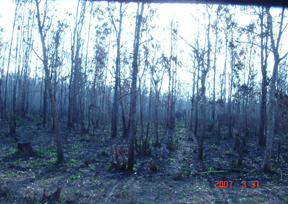Forest Fires in Nilgiri Biosphere
-Susan Sharma
Friends, who visited Thekkady recently, reported good sightings of wild elephant herds.
Parts of Mudumalai bordering Kerala too witnessed moving herds.
The herds were fleeing the forest fires raging in Wayanad and parts of Nagarhole National Park.
Forest Fires in over 6,000 sq km of the precious Nilgiris forests, a heritage ecosystem, has become an annual feature in the months of February/March.

What do forest fires do?
Hundreds of species birds, mammals, reptiles, insects and other micro organisms are wiped out in the fires.
Young ones and eggs of ground nesting birds like nightjars, larks, lapwings, peahens and so on are destroyed.
The young ones of mammals, reptiles and other slow moving fauna are also consumed since they
have no escape route. Ground fires also burn down useful wild herbivore forage and replace edible species with inedible exotic invader species like Chromolaena weed. This can upset the natural composition of the whole forest itself.
According to Dr Ullas Karanth, “repeated forest fires will encourage fire hardy species and eliminate floral species that are highly susceptible to human induced fires.
And over a period of time ‘fire climax vegetation’ will dominate the area”. Fire hardy species like Anogeisus latifolia (Dhaura), Cassia fistula (Indian Leburnum) will take over, affecting the diversity and floral composition of the area as seen in some parts
of Bandipur Tiger Reserve in Karnataka. Some weeds like Euputorium and Lantana have the capacity to regenerate better and flourish using the burnt plant material as fertilizing compost.
Prevention
The most effective prevention method of fighting fires is the elaborate network of fire lines and continuous vigil by the protection staff during the crucial fire season.
Watchtowers at crucial points which give good overview of large parts of the area, effective communication network, and mobility to reach affected areas swiftly are all important factors for effective fire protection. More funds, men and material have to be
allocated to the forest department to check forest fires.
Proficient vigil and effective prevention measures could prevent fires even in areas with high density of flowered bamboo-a case in point is Bhadra Tiger Reserve in
Karnataka. Forest department has reported very minimal fires in the whole of the reserve in the last three years.
Educating local communities, students, and teachers residing around protected areas prevents negligent fires or man-made fires with criminal intentions.
( Photograph of burnt forests in Wayanad range by Susan Sharma)